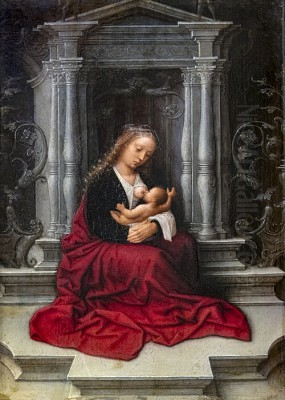
Adriaen Isenbrant stands as a significant figure in the Northern Renaissance, a painter whose prolific output shaped the artistic landscape of Bruges during the first half of the 16th century. Active roughly between 1500 and his death in 1551, Isenbrant operated a large and successful workshop, specializing primarily in religious subjects and devotional images that catered to the tastes of a prosperous clientele. While shrouded in some mystery regarding his origins and the precise attribution of many works associated with his name, his contribution to the continuation of the Early Netherlandish painting tradition, infused with subtle Italianate influences, remains undeniable.
Origins and Arrival in Bruges
The exact birthplace and date of Adriaen Isenbrant remain subjects of speculation among art historians. While he became intrinsically linked with the city of Bruges, where he spent his entire documented career, suggestions for his place of origin include Haarlem or Antwerp. What is certain is that he established himself in Bruges by 1509, the year he purchased his citizenship in the bustling artistic and commercial center. This move marked the beginning of a long and productive career in the city that had been a cradle of the Northern Renaissance.
A pivotal year for Isenbrant was 1510. In November of that year, he was formally admitted as a free master into the prestigious Guild of Saint Luke, the city's corporation for painters and sculptors. Simultaneously, he joined the Guild of Saint Eloi, associated with goldsmiths, indicating a breadth of skill or connection within the craft community. His acceptance into these guilds signified his official recognition as an independent artist capable of taking on commissions and apprentices.
Crucially, archival records indicate that Isenbrant established his workshop on the Korte Vlaminckstraat. This location placed him in direct proximity to the studio of Gerard David, who was then the leading painter in Bruges following the death of Hans Memling. This geographical closeness strongly suggests a professional relationship, with many scholars believing Isenbrant may have trained or worked within David's circle before establishing his own independent practice. The stylistic affinities between their works further support this connection.
The Isenbrant Workshop: A Hub of Devotional Art
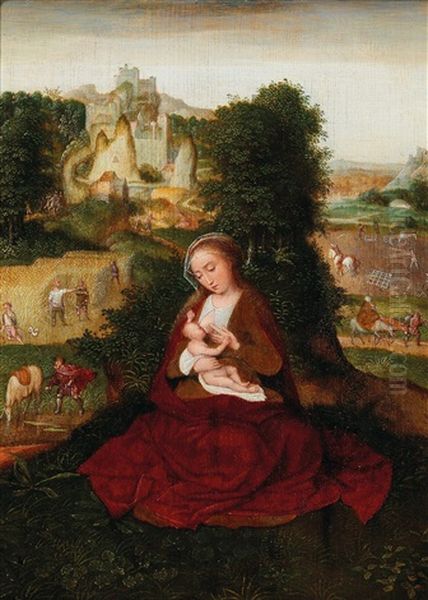
Adriaen Isenbrant quickly developed a reputation and ran one of the most productive workshops in Bruges during his time. His studio became a major supplier of devotional paintings, catering to both the local market and, increasingly, to export demands, particularly as Antwerp rose as a major commercial hub. The workshop specialized in religious themes that resonated with contemporary piety, including numerous depictions of the Virgin and Child, scenes from the Passion of Christ, and portraits of saints.
The success of the Isenbrant workshop relied on efficient production methods. Like many large studios of the era, it employed numerous assistants and apprentices who would execute parts of paintings, or entire versions of popular compositions, under the master's supervision. Isenbrant himself likely focused on the initial designs, the underdrawings, and the finishing touches, particularly on key areas like faces and hands, ensuring a certain level of quality control.
Evidence suggests the workshop utilized techniques to streamline production. The use of pouncing – transferring a design onto a panel using a preparatory drawing pricked with holes through which charcoal dust was 'pounced' – allowed for the replication of successful compositions. This practice, common at the time, facilitated the creation of multiple versions of popular subjects like the Madonna and Child or The Rest on the Flight into Egypt, meeting market demand but also contributing to the challenges modern scholars face in distinguishing the master's hand from that of his collaborators.
The workshop's output found favour among the affluent citizens of Bruges and merchants involved in international trade, including those from Spain and the Hanseatic League. Small-scale devotional panels, diptychs, and triptychs suitable for private chapels or domestic settings were particularly popular. Isenbrant also undertook portrait commissions, such as the notable Portrait of Paul de Nigro, demonstrating his skill in capturing individual likenesses within the prevailing Netherlandish style.
Artistic Identity: Style and Technique
Adriaen Isenbrant's artistic style is generally characterized as conservative, deeply rooted in the traditions established by earlier Netherlandish masters like Jan van Eyck, Rogier van der Weyden, and particularly Hans Memling and his own likely mentor, Gerard David. He did not pursue radical innovation in the manner of some contemporaries but excelled in refining and adapting existing models with a distinctive sensitivity and technical finesse. His approach is often seen as embodying the quintessential "Bruges style" of the early 16th century.
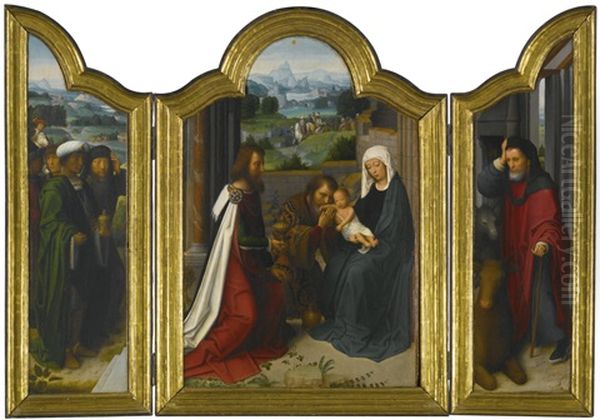
A hallmark of Isenbrant's (and his workshop's) style is the use of soft, warm colours. Palettes often feature gentle reds, greens, and yellows, contributing to a serene and often tender mood, especially in depictions of the Virgin and Child. He employed oil paint with considerable skill, achieving smooth transitions and delicate modelling of forms. His figures often possess rounded faces, gentle expressions, and somewhat idealized features, conveying a sense of calm piety.
Isenbrant was adept at using sfumato, a technique involving soft, hazy transitions between colours and tones, particularly noticeable in the modelling of flesh. This approach, famously associated with Italian Renaissance painters like Leonardo da Vinci, softens contours and creates a subtle atmospheric effect, lending figures a greater sense of volume and presence without harsh outlines. This distinguishes his work from the sharper linearity of some earlier Netherlandish painters.
Landscape backgrounds frequently feature in Isenbrant's paintings, often depicting idyllic, rolling hills, feathery trees, and sometimes distant castles or rivers. These landscapes, while drawing on the tradition of painters like Joachim Patinir, serve primarily as harmonious settings for the religious figures, enhancing the devotional atmosphere rather than being the main subject. They are rendered with care but often follow established formulas developed within the workshop.
While fundamentally grounded in the Netherlandish tradition, Isenbrant's work shows an awareness of Italian Renaissance developments, likely absorbed through prints or the work of contemporaries like Jan Gossaert who had travelled south. This is sometimes evident in the compositional structures or the idealized figure types, particularly in his Madonnas, which occasionally echo models popularized by artists such as Raphael.
Iconography and Key Works
The vast majority of works attributed to Adriaen Isenbrant and his workshop fall within the realm of religious iconography. Devotional images intended to inspire prayer and contemplation formed the core of his production. The Virgin Mary was a particularly favoured subject, appearing in numerous variations of the Madonna and Child theme, often depicted in tender, intimate moments.
One significant work often associated with Isenbrant, though subject to ongoing scholarly debate regarding attribution, is the diptych of The Seven Sorrows of the Virgin. Originally part of a larger ensemble in the Church of Our Lady in Bruges, this work exemplifies the emotional piety popular in the period. If indeed by Isenbrant, it would represent an important early commission. Many museums now hesitate to firmly attribute this specific piece directly to him, highlighting the complexities surrounding his oeuvre.
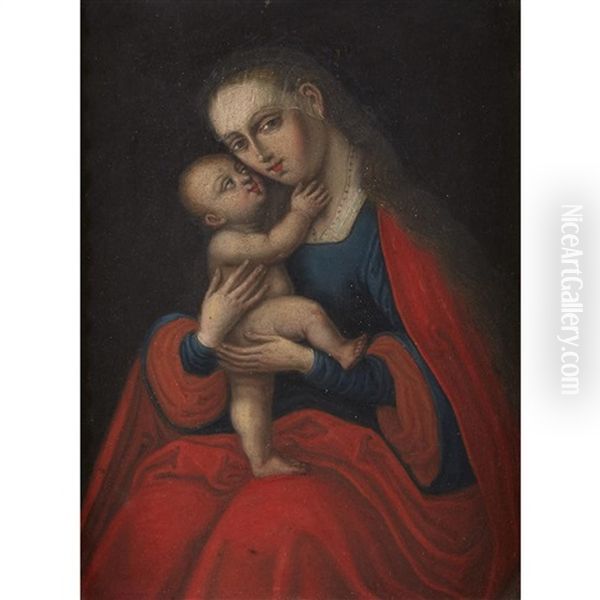
Other representative works give a clearer picture of his style. The triptych The Pilgrimage to Bethany (c. 1518) showcases his ability to handle multi-panel narratives. The Portrait of Paul de Nigro (Paulus de Nigro), a Genoese merchant active in Bruges, is a fine example of his portraiture, noted for its sensitive characterization, soft modelling, and meticulous rendering of textures.
Numerous versions of The Rest on the Flight into Egypt are attributed to Isenbrant or his workshop, depicting the Holy Family in serene landscape settings, a theme popularized by Gerard David. Similarly, depictions of the Adoration of the Shepherds and the Adoration of the Magi were standard repertoire items, often featuring the characteristic warm palette and gentle figure types associated with Isenbrant. A Madonna and Child housed in the Lázaro Galdiano Museum in Madrid is frequently cited as a characteristic example of his work in this genre.
The Temptation of Adam and Eve, located in a museum collection (the specific "Stenmeyr Museum" mentioned in the source text seems erroneous; similar works exist in various collections), demonstrates his handling of biblical narrative beyond the most common devotional themes. A Passion Altarpiece produced by the workshop, now in the Art Museum of Estonia, indicates the studio's capacity for larger-scale commissions, likely involving significant contributions from assistants. The Virgin and Child with the Milk Virgin represents a more specific iconographic type within his Marian imagery.
Networks and Collaborations
Isenbrant operated within a vibrant artistic community in Bruges, and his career intersected with those of several other notable painters. His most significant connection was undoubtedly with Gerard David. Whether as a pupil, collaborator, or simply a close follower, Isenbrant absorbed much from David's style and compositional models, becoming a key figure in perpetuating the Davidic manner in Bruges after David's death in 1523.
He also interacted with other contemporaries. Records show that in 1520, Isenbrant was one of several artists, including the renowned Jan Gossaert (also known as Mabuse), commissioned by the Bruges city authorities to contribute painted decorations for the Triumphal Entry of Emperor Charles V. This collaboration on a major civic project underscores Isenbrant's established position within the city's artistic hierarchy. The influence of Gossaert's more Italianate style can occasionally be discerned in some works attributed to Isenbrant, suggesting mutual awareness, if not direct collaboration beyond the 1520 project.
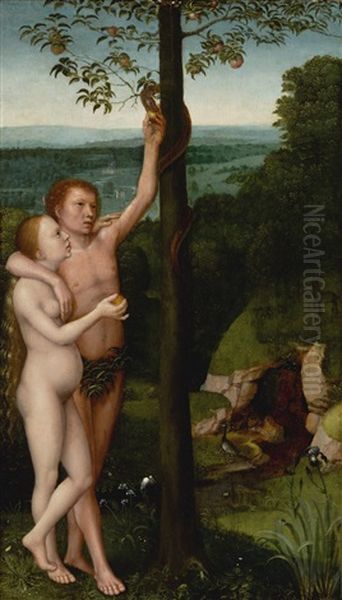
Another important Bruges contemporary was Ambrose Benson, an artist of Lombard origin who also ran a successful workshop, often competing for similar commissions. Stylistic similarities and shared compositional sources have sometimes led to confusion between the works of Isenbrant and Benson, particularly as both catered to a similar market, including Spanish patrons. Distinguishing their respective workshop outputs remains a challenge for art historians.
While based in Bruges, Isenbrant was certainly aware of developments in Antwerp, the rapidly growing economic and artistic powerhouse of the Low Countries. Artists like Quentin Matsys and Joos van Cleve were shaping the Antwerp school, blending Netherlandish tradition with newer Italian influences. Isenbrant's work reflects the broader artistic currents of the time, participating in the Netherlandish Renaissance dialogue between tradition and innovation.
Life Beyond the Easel
Documentary evidence offers glimpses into Adriaen Isenbrant's personal life, revealing a man active not only in his studio but also in civic and personal affairs, sometimes marked by complexity and even scandal. He held positions of responsibility within the painters' guild, serving as a vinder (dean or governor) on multiple occasions (in 1516-17, 1525-26, 1535-36, and 1537-38), indicating the respect he commanded among his peers.
Isenbrant married twice. His first wife was Maria Grandeel, the daughter of a painter named Peter Grandeel. They had one son together. Following Maria's death, Isenbrant married Clementine de Haerne in 1519. This second marriage produced three daughters. However, records suggest this union was not without difficulties. Isenbrant also fathered an illegitimate daughter with a tavern keeper, resulting in a documented affair and potential social complications.
Financial and legal matters also appear in the records. A notable incident occurred in 1534 when Isenbrant sued an agent or dealer regarding a contract. The details are somewhat obscure, but the case seems to have involved dealings related to the legacy or perhaps copies of works by the much earlier master Jan van Eyck, possibly concerning workshop practices or the sale of paintings in the older style. This suggests Isenbrant was engaged in the commercial aspects of the art market and protective of his business interests.
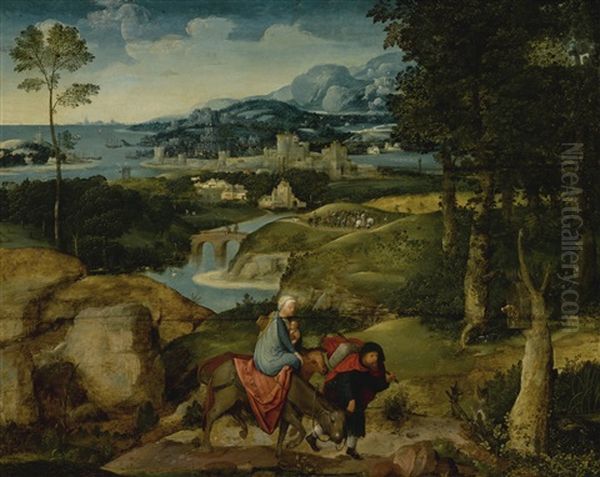
Adriaen Isenbrant died in Bruges in July 1551. He was buried in the cemetery of the Sint-Jakobskerk (St. James's Church), a parish church frequented by many artists and prominent citizens. His estate, which included four houses in Bruges and property outside the city walls, was divided among his second wife, Clementine, and his children (including the illegitimate daughter, who was provided for), indicating a degree of accumulated wealth from his successful career.
Enduring Legacy and Dispersed Works
Adriaen Isenbrant's legacy lies primarily in his role as a key practitioner and popularizer of the Bruges painting tradition in the early 16th century. He successfully adapted the stylistic language of masters like Gerard David to meet the demands of a changing market, producing a vast number of devotional works that found wide appeal both locally and internationally. His workshop became a significant force in disseminating the Bruges style.
However, the very success and productivity of his workshop contribute to the main challenge in assessing his legacy: attribution. The extensive use of assistants and the replication of popular compositions make it difficult to pinpoint Isenbrant's autograph work with certainty. Many paintings are now catalogued as "Workshop of Adriaen Isenbrant" or "Circle of Adriaen Isenbrant," acknowledging the collaborative nature of their production. The stylistic similarities with contemporaries like Ambrose Benson further complicate matters.
Despite these challenges, Isenbrant remains recognized for his characteristic blend of traditional Netherlandish detail, soft modelling influenced by Italian sfumato, warm colour harmonies, and serene, pious sentiment. His works represent a significant chapter in the history of Northern Renaissance art, particularly the final flourishing of the Bruges school before Antwerp definitively took over as the leading artistic centre in the Low Countries.
Works attributed to Adriaen Isenbrant and his workshop are found in numerous major museum collections across the world. Key institutions holding significant examples include:
The Groeningemuseum in Bruges, which houses several important pieces providing context within his home city.
The Museum Mayer van den Bergh in Antwerp.
The Lázaro Galdiano Museum in Madrid.
The Öffentliche Kunstsammlung in Basel.
The National Gallery of Finland in Helsinki.
The Art Museum of Estonia in Tallinn (workshop pieces).
Major museums in Brussels, Paris, London, New York, and elsewhere also hold works associated with his name or circle.
Conclusion
Adriaen Isenbrant navigated the transition from the late medieval artistic traditions of Bruges into the broader currents of the Northern Renaissance. As a master painter and head of a highly productive workshop, he played a crucial role in satisfying the burgeoning demand for devotional art in the early 16th century. While questions of attribution persist, the body of work associated with him is characterized by a gentle piety, technical refinement, warm colours, and soft atmospheric effects. He skillfully synthesized the heritage of Early Netherlandish painting with subtle contemporary influences, leaving behind a significant, albeit complex, artistic legacy that continues to be studied and appreciated for its contribution to the rich tapestry of Flemish art.